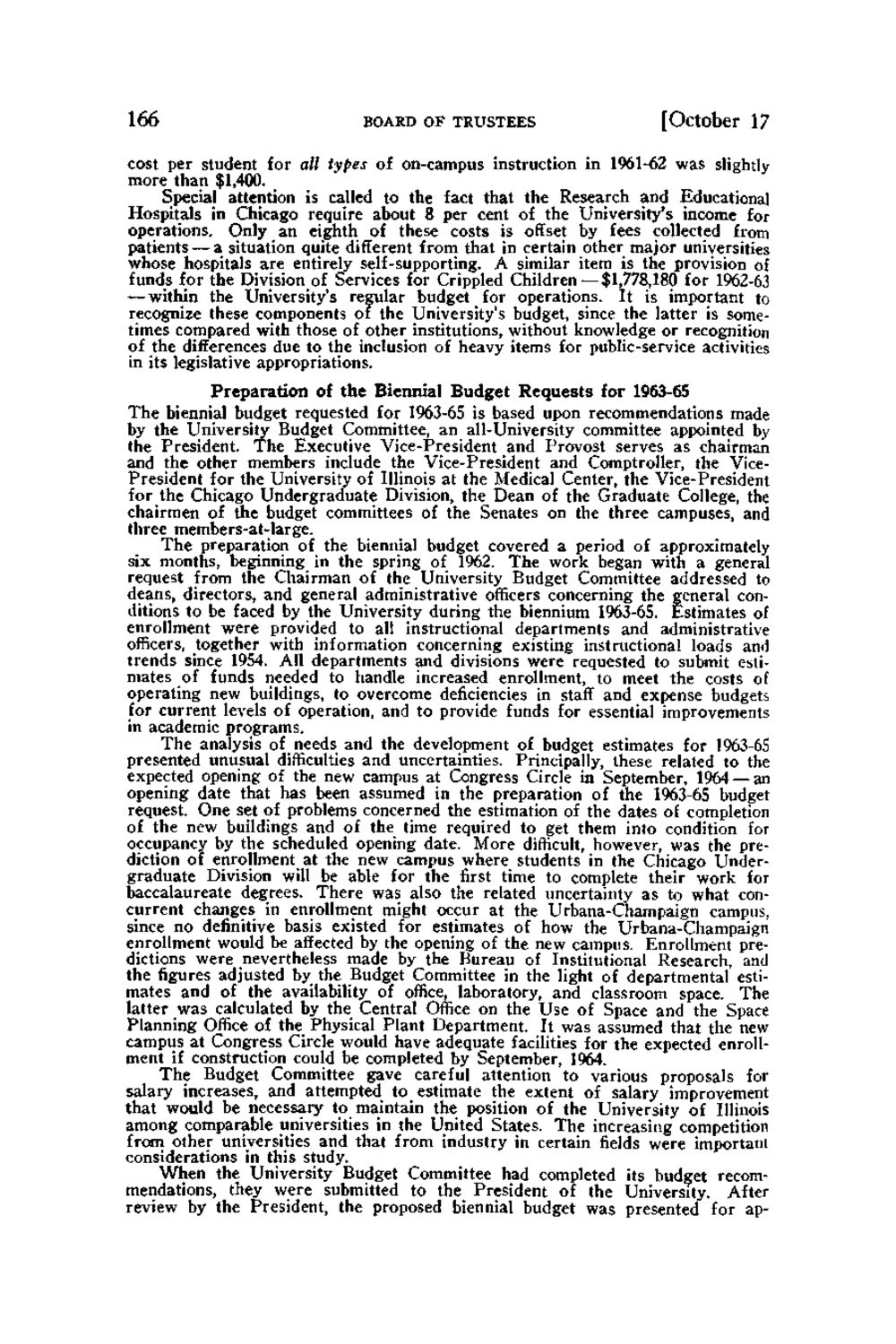| |
| |
Caption: Board of Trustees Minutes - 1964
This is a reduced-resolution page image for fast online browsing.

EXTRACTED TEXT FROM PAGE:
166 BOARD OF TRUSTEES [October 17 cost per student for all types of on-campus instruction in 1961-62 was slightly more than $1,400. Special attention is called to the fact that the Research and Educational Hospitals in Chicago require about 8 per cent of the University's income for operations. Only an eighth of these costs is offset by fees collected from patients — a situation quite different from that in certain other major universities whose hospitals are entirely self-supporting. A similar item is the provision of funds for the Division of Services for Crippled Children —$1,778,180 for 1962-63 — within the University's regular budget for operations. It is important to recognize these components of the University's budget, since the latter is sometimes compared with those of other institutions, without knowledge or recognition of the differences due to the inclusion of heavy items for public-service activities in its legislative appropriations. Preparation of the Biennial Budget Requests for 1963-65 T h e biennial budget requested for 1963-65 is based upon recommendations made by the University Budget Committee, an all-University committee appointed by the President. The Executive Vice-President and Provost serves as chairman and the other members include the Vice-President and Comptroller, the VicePresident for the University of Illinois at the Medical Center, the Vice-President for the Chicago Undergraduate Division, the Dean of the Graduate College, the chairmen of the budget committees of the Senates on the three campuses, and three members-at-large. T h e preparation of the biennial budget covered a period of approximately six months, beginning in the spring of 1962. The work began with a general request from the Chairman of the University Budget Committee addressed to deans, directors, and general administrative officers concerning the general conditions to be faced by the University during the biennium 1963-65. Estimates of enrollment were provided to all instructional departments and administrative officers, together with information concerning existing instructional loads and trends since 1954. All departments and divisions were requested to submit estimates of funds needed to handle increased enrollment, to meet the costs of operating new buildings, to overcome deficiencies in staff and expense budgets for current levels of operation, and to provide funds for essential improvements in academic programs. T h e analysis of needs and the development of budget estimates for 1963-65 presented unusual difficulties and uncertainties. Principally, these related to the expected opening of the new campus at Congress Circle in September, 1964 — an opening date that has been assumed in the preparation of the 1963-65 budget request. One set of problems concerned the estimation of the dates of completion of the new buildings and of the time required to get them into condition for occupancy by the scheduled opening date. More difficult, however, was the prediction of enrollment at the new campus where students in the Chicago Undergraduate Division will be able for the first time to complete their work for baccalaureate degrees. There was also the related uncertainty as to what concurrent changes in enrollment might occur at the Urbana-Champaign campus, since no definitive basis existed for estimates of how the Urbana-Champaign enrollment would be affected by the opening of the new campus. Enrollment predictions were nevertheless made by the Bureau of Institutional Research, and the figures adjusted by the Budget Committee in the light of departmental estimates and of the availability of office, laboratory, and classroom space. The latter was calculated by the Central Office on the Use of Space and the Space Planning Office of the Physical Plant Department. It was assumed that the new campus at Congress Circle would have adequate facilities for the expected enrollment if construction could be completed by September, 1964. T h e Budget Committee gave careful attention to various proposals for salary increases, and attempted to estimate the extent of salary improvement that would be necessary to maintain the position of the University of Illinois among comparable universities in the United States. T h e increasing competition from other universities and that from industry in certain fields were important considerations in this study. W h e n the University Budget Committee had completed its budget recommendations, they were submitted to the President of the University. After review by the President, the proposed biennial budget was presented for ap-
| |